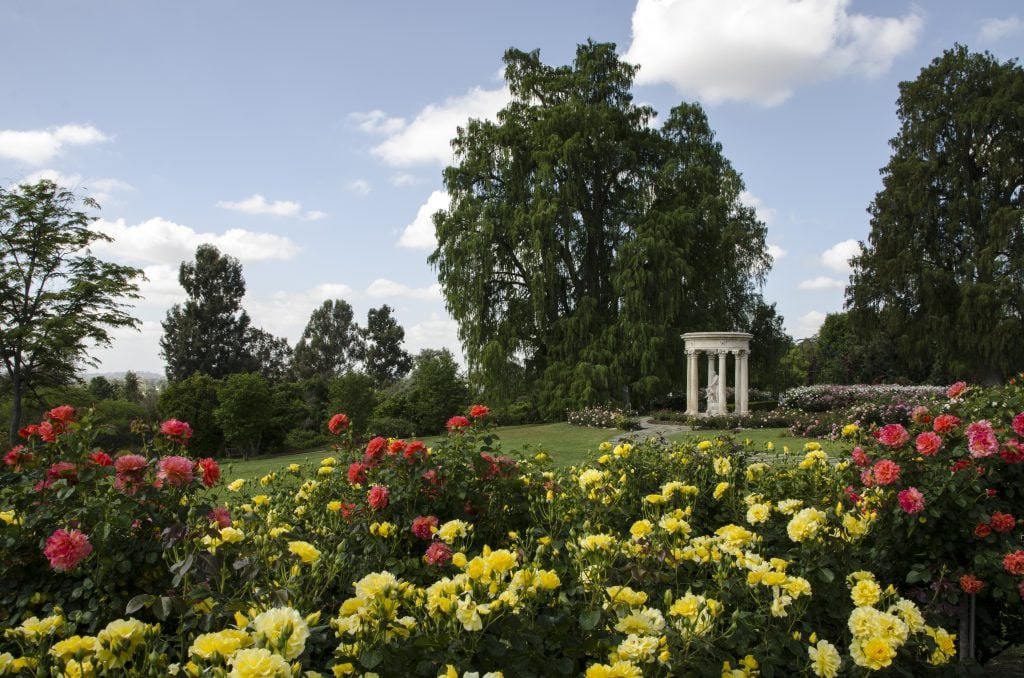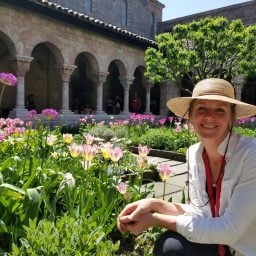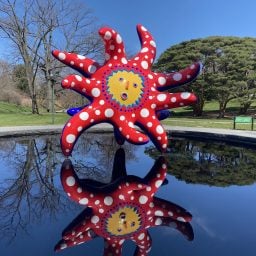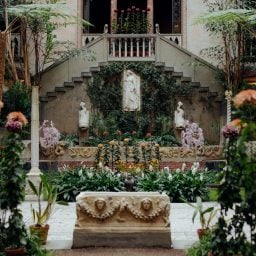Imagine roses meeting your eye in every direction—thousands upon thousands of them, cascading in blush pinks, magentas, butter yellows, lilacs, and scarlets, draping over pergolas, winding around green lawns, and filling the air with sweet perfume.
This dreamlike splendor is a waking reality at the famed Rose Garden at the Huntington Library in San Marino, California, one of over a dozen themed gardens on the institution’s 120 acres (which also include a Shakespeare Garden, a Japanese Garden, and a Desert Garden, among others).
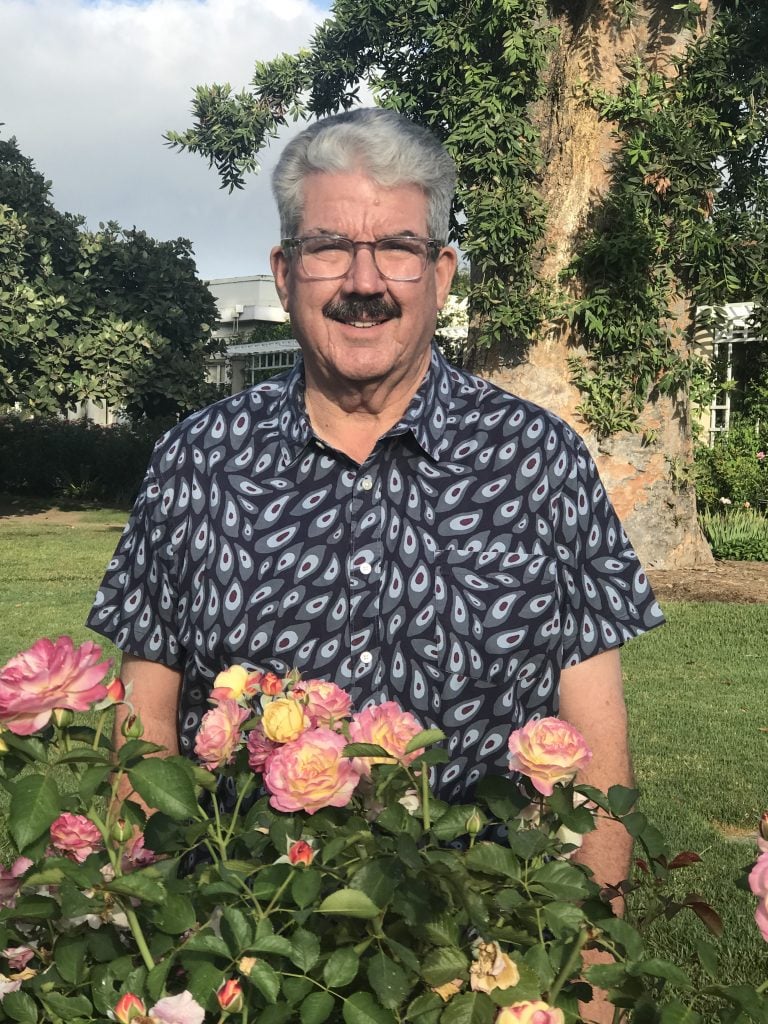
Tom Carruth, the curator of the rose collection at the Huntington Library, 2019. Courtesy of Tom Carruth.
The Rose Garden was originally created in 1908 for Henry and Arabella Huntington. Arabella had a particular fondness for roses and the garden’s original intent was to provide blooms for the opulent bouquets on display within the mansion itself.
Today, the Rose Garden is a favorite among visitors to the Huntington, with over 3,000 rose bushes in more than 1,300 varieties created between 1540 and the present day.
These flowers are essential to the Huntington’s collection, which of course also includes masterworks of art. Many rose-inspired works can be found on view too, from a Jean-Honoré Fragonard painting of Cupid wreathed in roses to William Morris’s famed designs.
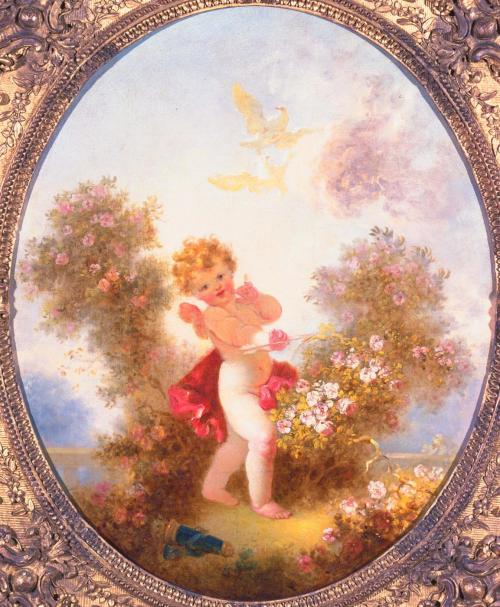
Jean-Honoré Fragonard, Cupid Among Roses, or Love the Sentinel (ca. 1775). Courtesy of the the Huntington Library, Art Museum, and Botanical Gardens.
Overseeing this lush garden is horticulturist Tom Carruth, the curator of the rose collections. Carruth is something of a rose-world celebrity himself, having created over 150 rose hybrids during his career, including the “Huntington’s 100th,” a lovely blossom named specifically for the institution’s centennial (more on that later!).
A Texas native with a looping drawl, Carruth says cultivating the rose garden—and bringing it to the height of its splendorous possibilities—has been both a project of passion and an educational mission.
We spoke with the rose man himself about how he first fell in love with flowers and what we can learn from them.
Let’s start at the very beginning. How did you become interested in horticulture in the first place?
I was born in the panhandle of Texas, in a little town called Pampa. Very early on I had an interest in flowers. In fact, I was five or six years old when I told my parents I wanted to work with flowers. That kind of blew dad’s mind, but of course, they thought that meant I could only be a florist.
I had my first rose garden when I was 11. I had sold Burpee catalogue seeds that summer to make enough money to buy a rose collection from a mail-order nursery. The collection was nine roses—that ensconced that love of roses.
Then, in junior high and high school, I became fascinated by genetics. Plant breeding was a good combination of these interests. I went to school at Texas A&M and earned my bachelor’s in horticulture, then my master’s in plant breeding.
How did you wind up coming to the Huntington? I love that your title is the curator of the rose collection.
I’ve lived in the Los Angeles area since 1976. I volunteered at the annual plant sale at the Huntington in 1978. I’ve known the institution for quite a while. And Katie, it’s not because I’m altruistic that I was a volunteer—it’s because volunteers get the first choice of the plants!
I’ve seen the garden, over many seasons, wane and flourish and go through all kinds of problems and come back. After a full career as a hybridizer, I was looking to step out of that industry, which had gone through some severe changes and reductions since 2008. In 2012, the Huntington was about to receive a gift from one estate specifically for the gardens. I thought, “This is a good time to step in and guide the remodel of the Rose Garden,” which needed a lot of refurbishment, restoring the soiling, general infrastructure. That’s been one of my big goals while I’ve been here: to see it through that remodeling and make the garden into the dream that it can be.
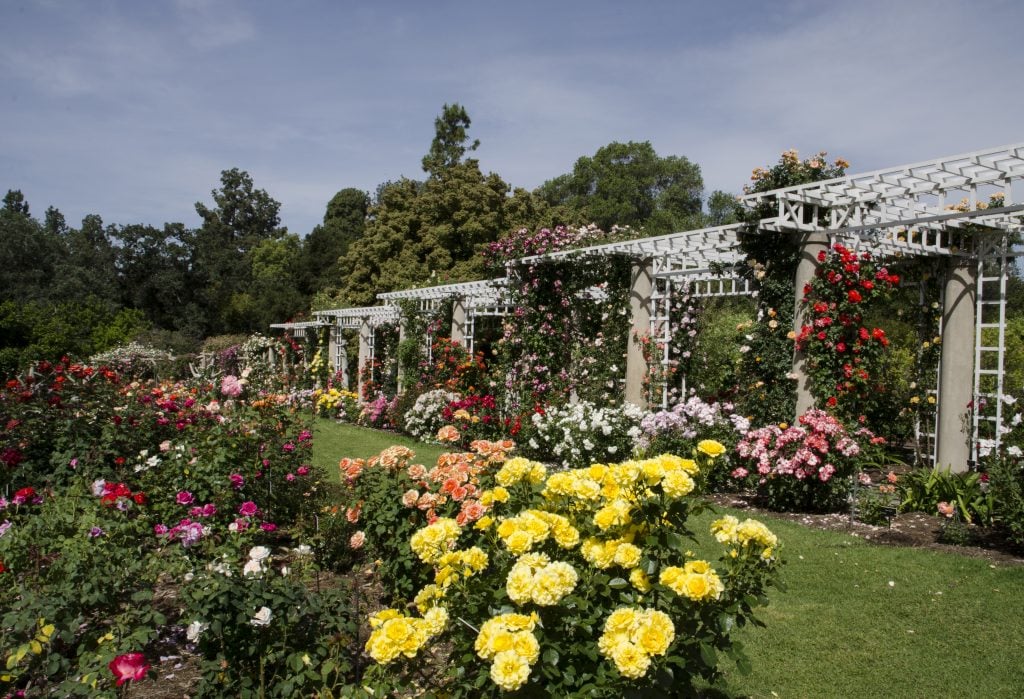
View of the Rose Garden. Courtesy of the Huntington Library, Art Museum, and Botanical Gardens.
What does an average day of work look like in the Rose Garden?
I’m out in the garden early to work with the volunteers or educate them a little bit or guide them as they’re working to build a sense of camaraderie. We have 44 volunteers in the garden alone; there are 1,400 volunteers at Huntington in total.
I also talk with my staff to make sure we’ve got tasks in line. All our roses are tagged and inventoried, just like the objects in the museum collection. Similarly to the museum, with [lockdown], we were not able to bring in any of our docents into the garden, so I began to serve as a docent at this time, just greeting people, inviting them to step on the grass and smell the roses, and give them a little education if they would allow.
Roses are always fun to pull people in with fragrance. I always want to make sure children feel welcome too, and get to know roses from an early age. Hopefully, we can create another generation of gardeners.
What was it like to work in the garden during lockdown?
It was heartbreaking, really. We were about to come into our major spring push and the garden looked absolutely spectacular, and no one was there to see. I turned into a social media whore, just putting out there as much as I possibly could to keep us in people’s minds. Once we reopened in July 2020, people came into the garden and began to weep, they had missed it so much. There’s a big emotional tie to the garden—memories made there. People who came here as school students return as adults with their children.
You’ve created over 150 hybrids of roses in your career, which is quite incredible and an accomplishment for which you’ve won numerous awards. Can you explain the hybridizing process to those of us who are not familiar?
It’s a 10-year process to bring a new variety forward. You start with a goal—color, fragrance, hardiness— and you try to pick pairs that you think would combine to give you that goal. In the greenhouse, you perform pollinations by hand and then collect the seed and sprout those out, but you don’t grow those into roses. Roses don’t come true from seeds. To help people imagine it a little better, it’s like kids in a family: they have the same parents, they have certain similarities, but each one is a unique individual.
The same is true for all the seeds in any one rosehip. Each one will be different. These seeds start sprouting and flowering, which happens quite quickly, and you can start making decisions as to whether they get retained or destroyed. Part of the tenure process is going from one plant of that kind to several thousand plants of that kind by asexual propagation—usually grafting or cuttings. If you’re going to introduce the variety, you’ll need several thousand.
Can you tell me about the Huntington’s 100th, a hybrid of rose named specifically for the Huntington’s centennial anniversary?
Remember, introducing a rose is a 10-year process. In 2016, my crew and I began to exchange ideas about what we could do for our upcoming centennial in 2019. We went up to the rose fields in Wasco, California, where we saw this new variety, yet to be introduced, that caught my eye, and took some photos of it. The rose was slated to be introduced in 2019, I learned, and bells went off. Ding ding!
In a unique situation for roses, we purchased the naming rights of the variety just to honor our centennial. The plants went into the ground two years ahead of the centennial with no label, just to get public opinion, and later we made the formal announcement. The variety has caught on very well. It’s a hell of a bloomer with nice color, and is very fragrant.
This may be an impossible question, but do you have a favorite rose?
We have over 1,300 varieties in the collection, so my favorites change pretty frequently. But I will say now that my career’s coming to a close as a hybridizer, my best rose might be Julia Child. It was a nationwide winner, and whereas many roses look drastically different depending on where you plant them, Julia Child is one of those rare ones that looks the same everywhere it goes—golden and beautiful.
It’s been introduced internationally more broadly than any of my other roses—in the U.K., France, South Africa, Australia, New Zealand. Almost every breeder jumped on it immediately for blend lines, which is the ultimate compliment from other hybridizers. You’ll be seeing offspring of Julia for quite a while!
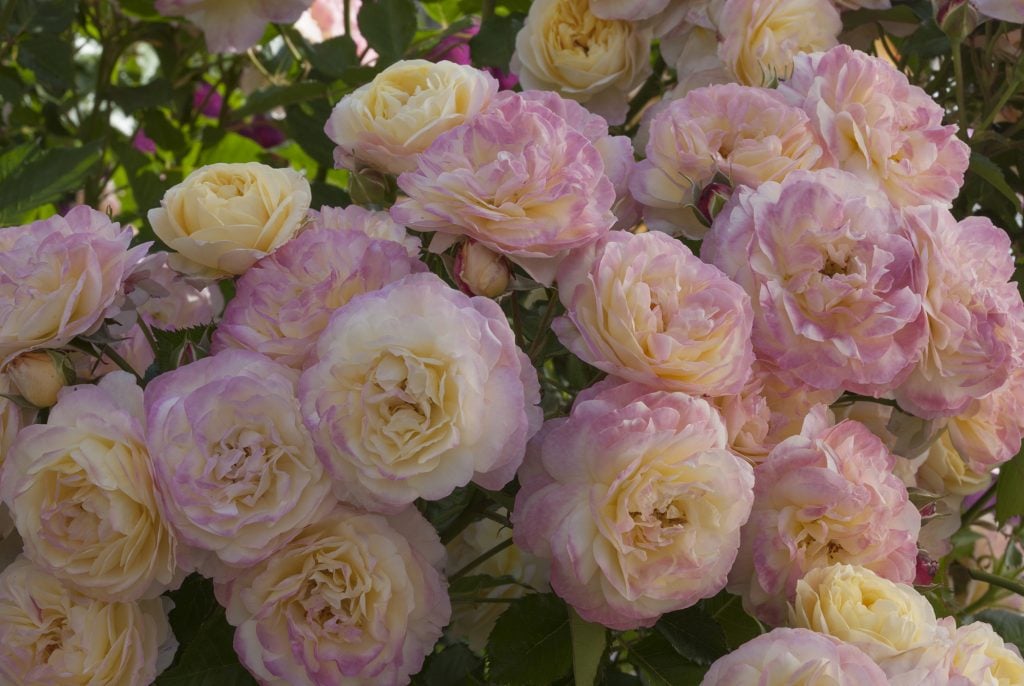
The Huntington’s 100th, a rose variety named to mark the Huntington Library’s centennial anniversary. Courtesy of the Huntington Library, Art Museum, and Botanical Gardens.
Of course, I need to ask about the rose’s name, Julia Child. How did that come about?
I had wanted to name a rose after Julia Child for a long time, and we’d approach her and she’d always say, “Oh, I’m not worthy.” But we had a customer with an unusual operation in the Santa Barbara area where she was growing roses outdoors for cut flowers that had more of a garden look to them. I would sometimes send her some of the unnamed seedlings right before introduction, just to see how they’d perform for her. As it turns out, she was family friends with Julia through the restaurant industry.
Julia came over one night for dinner and wandered through the rose garden with her and saw this seedling in flower and said, “Well, if there were ever a rose with my name, I would like that one.” The customer called us the next morning and told us—of course, we jumped right on it. Julia never loaned out her name for anything and had she not been alive to approve it, of course her lawyers would not have allowed it. In the description, we tried to use as much culinary language as possible—a butter gold, an abundance with old-fashioned form, and a licorice candy fragrance. It’s a truly great plant. I’m very, very honored to have that rose with her name.
Tell me about the color of roses. Are some colors more desirable than others?
Some colors are more difficult to achieve than other colors. There is no true blue—that is the color of longing for the impossible. Nor is there a true black. Just within my career that we were able to get more saturated yellow colors, and novel, interesting colors with umber tones and lavender. Gray tones are the hot colors in the wedding industry right now.
That’s fascinating. I never really thought about roses going through color vogues.
Rose colors are very much influenced by fashion, but there’s that 10-year process. In the 1960s, the breeders were working hard on true saturated colors: deep yellows, deep reds, pure orange. Well, they achieved a pure orange, but it was completely out of favor at that point! The taste for that didn’t come back in for another 20 years. You can do all that work and then miss the window.
Which colors are on-trend now?
Still the lavenders and purples, as well as deep gold colors. Pink is kind of passé, still. But it’s all depending on who’s doing the selecting. If a man selects roses, he selects red. A woman, well, the last color she selects is red.
What do you think roses can teach artists—or anyone?
The magic of roses is that they can make someone stop to see the beauty that’s around them, and recognize the detail that Mother Nature puts into even the tiniest blossom.
